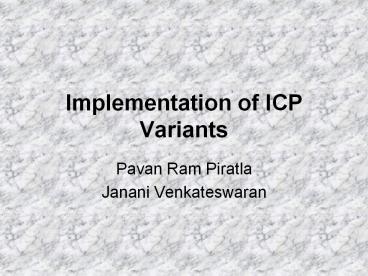Implementation of ICP Variants PowerPoint PPT Presentation
Title: Implementation of ICP Variants
1
Implementation of ICP Variants
- Pavan Ram Piratla
- Janani Venkateswaran
2
Outline
- Introduction
- Comparison
- Individual ICP stages
- Parameters for comparison
- Issues
- Conclusion
- Results
3
Introduction
- Implementation and comparison
- Original ICP algorithm
- Modified variant (more efficient)
- Algorithm modified in a couple of stages
4
Comparison
- Besl and McKay 92 method for registering 3D
shapes - Based on iteratively finding the nearest point to
a given point on a model - Variation based on a comparison paper by
Rusinkiewicz and Levoy 2001
5
Stages
- Point selection
- Point matching
- Weighting
- Outlier removal
- Error metric
- Error minimization
6
Parameters
- Random sampling of points on the surface
- Most computationally expensive step finding the
closest point - n points single point query complexity of
O(n). - m samples Complexity is O(mn)
- The closest-point can be calculated with more
efficiency by using other data structures like a
kd tree or by caching
7
Octree
- Efficient version
- Simplified implementation of an Octree
- An octree works by subdividing the space into
cubes
8
Octree
Root node Subdivided into 8 parts
9
Implementation
- Using the octree, we can prune large areas
without needing to consider them at all - When the cube we consider has no triangles, we
disregard that section of the octree - Complexity is reduced drastically the octree has
a constant lookup time
10
Point-to-point matching
- We perform closest-point matching by using a
point-to-point metric - The ICP algorithm requires preprocessing to
generate an octree - The 1D representation accumulates information
- Much faster than the initial ICP algorithm using
octree
11
More Parameters
- Weighting Does not substantially affect
performance - Rejection of outliers Decreases speed and
performance - Error metric We use the l2 distance as the error
metric - Minimize the e value at each iteration
- Terminating condition RMS residual error
12
Alternate issues
- Speed increase using closest-point caching
- If the termination threshold is small, caching
significantly improves performance - Fastest surface point computation can be used
13
Advantages and disadvantages
- Works much faster
- Less computation
- Requires preprocessing for the octree
- Trade-off is worth it
14
Results
- Ran the iterations on the Stanford bunny
- Used the simplified octree to find the closest
point efficiently - Randomly sampled points on it
- Iterations converge quickly
- Results will be displayed at the end of the
presentation
15
(No Transcript)
16
Bunny Model 000
17
Bunny Model 045
18
Bunny Model 0045
19
Bunny Model 0045 Fast
20
Bunny Model 4500
21
Conclusion
- Compared the two algorithms
- The efficiency in finding the closest point
- Results show the iteration convergence and the
lower computation required to perform it
22
References
- Fast and Accurate Shape-based registration David
A. Simon - http//www.ri.cmu.edu/pub_files/pub1/simon_david_1
996_1/simon_david_1996_1.pdf - The Stanford 3D scanning repository
- http//graphics.stanford.edu/data/3Dscanrep/
- http//www.gametutorials.com/Tutorials/OpenGL/Octr
ee.htm
23
THANK YOU!

